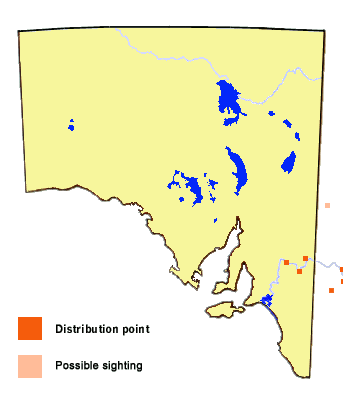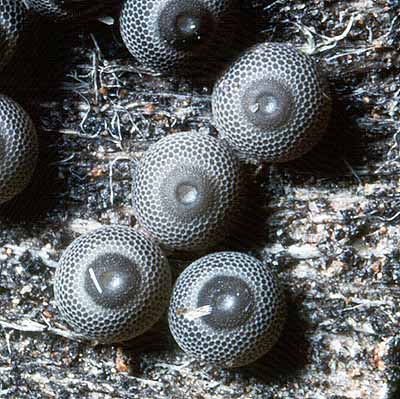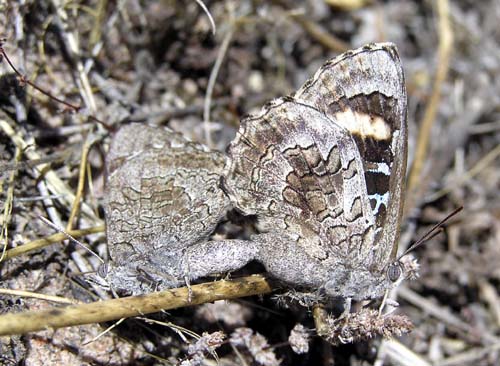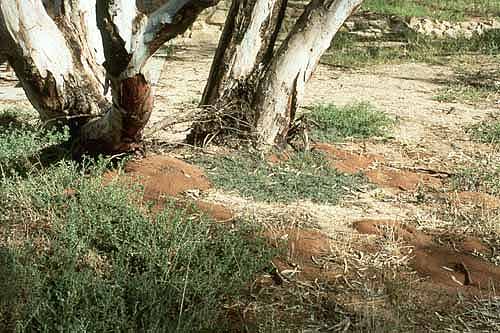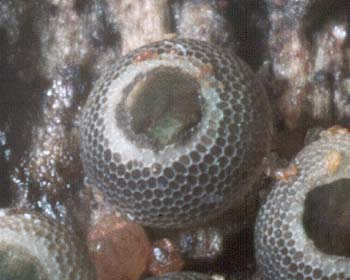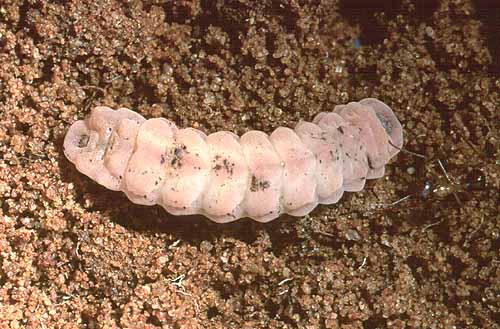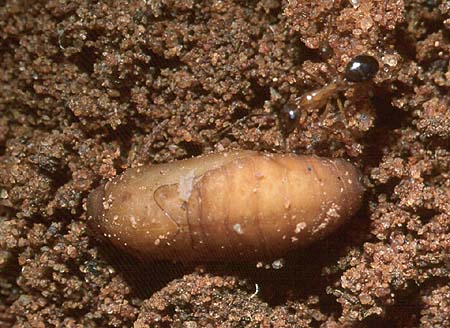Mallee Bronze Azure
Ogyris subterrestris subterrestris (Field)

Interesting Aspects
These butterflies are rarely seen flying, and when they do fly it is usually below about head height. This butterfly, like all other Ogyris species, has cryptically marked undersides, which makes the butterflies indistinguishable from the rough bark of trees and bushes, or the ground, when they are settled with wings folded.
The butterfly belongs to the compact O. genoveva - O. idmo Species Group of interesting Lycaenid butterflies within the Ogyrini Tribe, having very similar morphology and which are closely associated with the large Camponotus sugar-ants. O. subterrestris, along with O. halmaturia and O. otanes (all found in South Australia) and O. idmo (found in Western Australia) form the isolated O. idmo Species Subgroup within this group, as these four species have very similar adult morphology and early stages that associate only with Camponotus terebrans. O. subterrestris is one of the more specialised species of the sub-group having larvae which are believed to be predatory on the immature stages of these ants, which would allow these species to overcome the adverse effects of the periodic loss of foodplant, particularly from bush-fires, from which the very similar Ogyris otanes suffers.
It is presumed these butterflies have evolved from O. otanes type butterflies. Larvae of the latter will often strip their foodplants bare, and as they are incapable of moving to another nearby foodplant bush, those larvae not big enough to pupate, will perish. It is a small step for these larvae to either feed on other larvae within the colony (carnivorous feeding), or feed on the immature stages of the ants (myrmecoxeny) or on coccids that also associate with the ants. Lycaenid larvae often eat their own kind when their food source becomes insufficient to support all the larvae, and there are many Lycaenid species already known to practice myrmecoxeny. However, although it was probably a successful specialisation historically for Ogyris butterflies, it has not been very successful with the coming of European style habitation, as even though the ants are widespread and common, O. subterrestris (and Ogyris halmaturia the other myrmecoxenous butterfly in the group occuring in South Australia) are more threatened than O. otanes and have not adjusted very well to agricultural and urban development.
The Camponotus ant nests with which this butterfly is associated with, are usually situated at the base of tall mallee eucalypts (of various species), but will also utilise other trees and lower shrubs. There is usually more than one nest entrance around the base of the larger trees. The ants are nocturnal, and are large and ferocious (but without a sting). Adult butterflies emerge in the late morning after the ant activity above ground ceases. Newly emerged butterflies are covered in a loose fluffy down which may help protect them from ant attacks. They crawl up and out of the ant nest entrance, along the tree trunk, and after reaching about a metre from the ground, will then stop to expand their wings. This entire emerging process can take from 15 - 30 minutes before flight takes place.
Males usually congregate in open lek areas separate from the brood areas, and mostly wait settled with closed wings on or near ground level. Newly emerged females fly out to the males to mate, then return to the brood areas where they remain, separated from the males. As the ants are nocturnal, very little ant activity occurs above ground during the midday heat. Consequently, the female does most of the egg laying at this time, which she does by seeking out the ants nests, and usually those that already contain butterfly brood. She usually lands near the base of the trees containing the ant nest, and then walks down to the ant nest entrance to check for the presence of ant activity, and if all clear she will proceed to lay eggs. These are usually laid on the tree trunk, or even inside the entrance to the ant nest, and she does this by backing into the entrance upside down as far as she thinks it is safe to go without provoking an attack by the guard ants. She gains further ground by extending her abdomen considerably before proceeding to lay her egg cluster. More timid females will lay above the ground level entrance to about 5 cm, but in some instances up to 30 cm from the entrance. The eggs are also sometimes laid on bark or leaf debris, or even stones on the ground near the ant nest entrance. The further the eggs are placed away from the ants' nest entrance the more they will be subject to predation and parasitoids.
This butterfly has only recently been scientifically described, prior to which it was confused with the similar, but larger Ogyris halmaturia. It is unlikely that the two butterflies would occur together, due to their different ecological requirements. The two are difficult to tell apart. There are subtle morphological differences, but adult O. halmaturia butterflies (found in South Australia) differ from O. subterrestris mainly by being significantly larger. Flight period and location would also be important differentiation criteria.

